One of the hurdles many language learners face is the intricacies of verb conjugation. In Italian, mastering verb conjugation is crucial for effective communication. However, with the right approach and some helpful tips, you can easily remember Italian verb conjugation rules.
In this article, you’ll find the best strategies to master and how to easily remember Italian Verb conjugation rules.
When you discover a new verb in Italian, you realize this “raw” form.
To use the verb effectively, you must first understand the conjugation rules.
Conjugating Italian verbs have the same difficulties as conjugating verbs in other Romance languages due to the richness and diversity of the verb forms used but conjugation in Italian is not as tough as it appears.
The key is to divide the language down into little chunks and memorise the ends for each verb tense.
IMPORTANT Note for Learners:
This page is designed for beginner-level students of Italian.
For simplicity, it does not cover all irregularities or exceptions related to Italian verbs.
The content focuses on foundational rules and commonly used structures to help learners build their basic understanding of the language.
For advanced rules and exceptions, additional resources are recommended.
What is a verb conjugation?
Conjugation is the set of patterns that a verb can take to indicate:
- person,
- tense,
- mood.
PERSON
There are six different types of person in Italian:
- IO (I) – First Person Singular,
- TU (You) Second-Person Singular,
- LUI/LEI (He/She/It/One) Third-Person Singular,
- NOI (We) First-Person Plural,
- VOI (You) Second Person Plural
- LORO (They) Third-Person Plural (You).
For each person, we must conjugate a verb.
TENSE
Verbs are conjugated according to their tenses as well. The verb tense of a sentence indicates when the event in the phrase is taking place:
- In the present,
- In the future,
- In the past.
When conjugated according to tense, regular verbs follow a standard pattern.
MOOD
In grammar, mood refers to a verb category or form that specifies whether the verb represents:
A fact ☞ INDICATIVO (indicative mood)
A command ☞ IMPERATIVO (imperative mood)
It’s used to order or ask someone to do something, to offer advice or encouragement, to give instructions, or to make suggestions:
A condition ☞ CONDIZIONALE (conditional mood)
It’s used to make requests and to refer to situations that are uncertain or which depend on something else happening or being the case:
A wish or potential ☞ CONGIUNTIVO (the subjunctive mood)
This mood is used to express a wish, doubt, demand, or hypothetical situation.
Conjugation in the Italian verbs
In Italian, a verb is identified by the last three letters of the infinitive (the form used in dictionary entries):
In Italian, there are 3 of these conjugations:
- 1st conjugation of verbs ending in -are as parl-are (to speak)
- 2nd conjugation of verbs ending in -ere as cred-ere (to believe)
- 3rd conjugation of verbs ending in -ire as dorm–ire (to sleep)
Each verb includes an invariable element (the stem) that holds the meaning and a conjugated part (the ending) that indicates the person, tense, mood, and other characteristics.
Stems are crucial because they are the structures connecting each verb to the different tenses

Remember Italian Verb conjugation rules.
To conjugate verbs, you must first know who or what the subject is, as well as the tense and mood.
The verb stem, which you get by removing the -are, -ere, or -ire suffixes, tells you what to add based on the subject.
The stem of parlare, for example, is parl-.
You add subject-specific ends to this stem.
Each subject needs a distinct ending.
In the present tense:
Io (I) means that you add an -o to the verb stem: Io parlo, (I speak).
Noi (we) gets the ending –iamo, as in Noi parliamo (We speak).
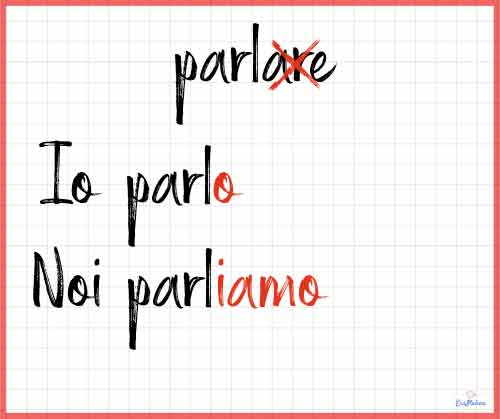
💡Although in English you can’t use a verb without naming the subject, in Italian, the endings tell you what the subject is.
In a sense, the subject pronouns are redundant in Italian.
Understanding the difference between regular and irregular verbs is key. Regular verbs follow predictable conjugation patterns, while irregular verbs have unique forms that must be memorized individually. Start with regular verbs to build your confidence and gradually tackle irregular ones.
⚠️ Regular verbs do not change their stems or roots so the stem remains the same when conjugated.
⚠️ Irregular verbs change their stems so they may change form once it has been conjugated.
They don’t follow a pattern of standard endings. Therefore, you need to memorize them.
Most irregular verbs belong to the second conjugation (ERE).
Italian verb conjugation follows patterns that can make your learning process easier. Recognize similarities between different verbs and use them to your advantage. Once you identify a pattern, it becomes a template for conjugating other verbs within the same group.
The Anatomy of ITALIAN Verb
| Conjugation | Infinitive | Verb in English | Stem | Infinitive Ending |
|---|---|---|---|---|
| First | parlare | to speak | parl- | are |
| Second | rispondere | to respond | rispond- | ere |
| Third | partire | to depart | part- | ire |
Remember the Italian Verb Conjugations Rules for Regular -are verbs
Verbs of the first conjugation ending in “–are” are the most common verbs in Italian.
The subject of a regular -are verb is indicated by the ending, which is added to the stem.
To use an -are verb, first, you remove the letters –are from the infinitive, which leaves you with the stem:
infinitive → parlare
stem: → parl-
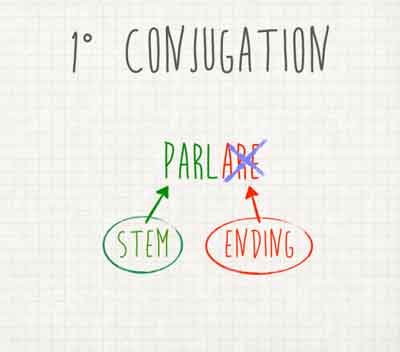
To the stem, you add the ending (-o, -i, -a, -iamo, -ate, or -ano) that reflects the subject (io, tu, lui, lei, Lei, noi, voi, loro) (example of ending for the present tense)
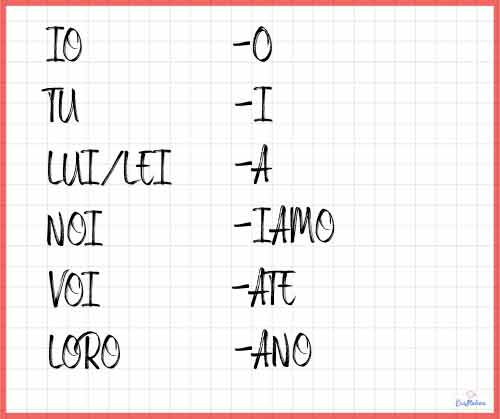
Common regular -are verbs
- abitare (to live)
- amare (to love)
- ballare (to dance)
- cambiare (to change)
- cantare (to sing)
- compare (to buy)
- domandare (to ask a question)
- giocare (to play a sport or game) (adds -h- in the tu and noi forms)
- guardare (to look at)
- lasciare (to leave)
- mangiare (to eat) (drops the -i- in the tu and noi forms)
- pagare (to pay) (adds -h- in the tu and noi forms)
- studiare (to study) (drops the -i- in the tu and noi forms)
- suonare (to play an instrument)
- trovare (to find)
Where to place the stress of a conjugated –ARE verb?
When pronouncing all forms of the verbs, note that—except for noi and voi — stress should be placed on the stem of the verb, not the ending. Although there are exceptions, this is particularly helpful to recall when pronouncing the third-person plural (loro).
Remember Italian Verb conjugation rules for Regular -ere verbs
Verbs of the second conjugation end in –ere.
This is the second-largest category of Italian verbs.
In regular- –ere verbs, the person, or subject, is indicated by the ending, which is added to the stem.
To use an –ere verb, first, you remove the letters –ere from the infinitive, which leaves you with the stem:
infinitive → leggere
stem: → legg-
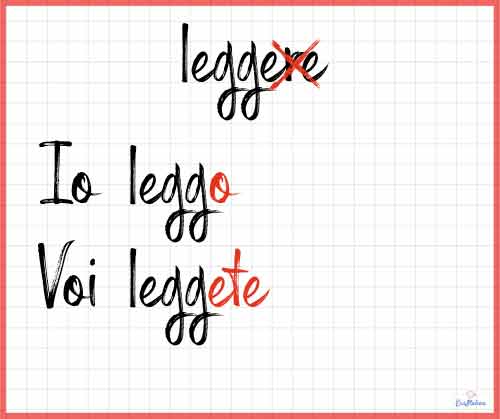
The stress pattern in -ere verbs can be of two types.
In the infinitive form, some verbs have the stress on the penultimate syllable (vedere,temere) similar to the -are verbs, but most have the stress on the stem (vendere, prendere, spendere), or the third-to-last syllable.

Common regular -ere verbs
- accendere (to light)
- cadere (to fail)
- chiedere (to ask)
- chiudere (to close)
- credere (to believe)
- leggere (to read)
- mettere (to put)
- prendere (to have/to take)
- ricevere (to receive)
- ripetere (to repeat)
- rispondere (to answer)
- scendere (to go down)
- scrivere (to write)
- spendere (to spend)
- vedere (to sea)
- vincere ( to win)
- vivere (to live)
Remember the Italian Verb conjugation rules for Regular –ire verbs
Verbs of the third conjugation end in -ire.
In regular-ire verbs, the person, or subject, is indicated by the ending, which is added to the stem.
To use an –ire verb, first, you remove the letters –ire from the infinitive, which leaves you with the stem:
infinitive → dormire
stem: → dorm-
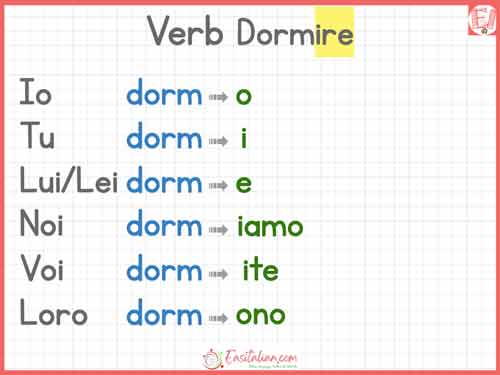
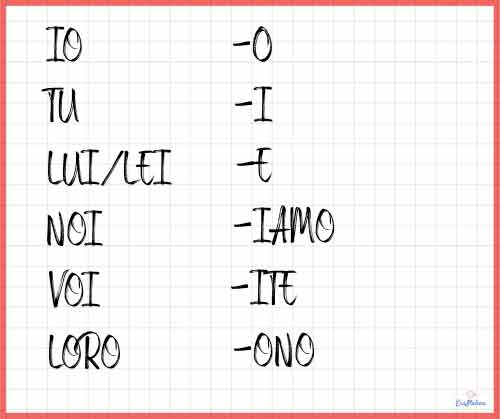
There are two groups of –ire verbs.
The first group follows conjugation rules (for the present tense) similar to those for the –ere verbs except for the voi form.
♦ dormire (to sleep)
- (io) dorm-o
- (tu) dorm-i
- (lei/lui) dorm-e
- (noi) dorm-iamo
- (voi) dorm-ite
- (loro) dorm-ono
The second is known as an”isc” verb because all the conjugated forms, except for noi and voi, insert the letters –isc between the stem and the endings.
Group of IRE verb with –isc adds
This group of the –ire verbs adds -isc between the stem and the ending in first, second, and third-person singular and third-person plural ONLY IN THE PRESENT TENSE.
The most of of these verbs (capire, finire, ferire, preferire, pulire) include one consonant and one vowel just before the –ire ending.
How do you know which verbs take “isc” in their conjugation?
You don’t. You have to refer to the dictionary, which shows the conjugation right after the infinitive.
Common type 1 -ire verbs
- aprire (to open)
- dormire (to sleep)
- fuggire (to escape)
- offrire (to offer)
- partire (to depart)
- seguire (to follow)
- sentire (to hear)
Common type 2 -ire verbs
- capire (to understand)
- finire (to finish)
- preferire (to prefer)
- pulire (to clean)
- colpire (to hit)
- costruire (to build)
- guarire (to cure)
- sparire (to disappear)
- suggerire (to suggest)
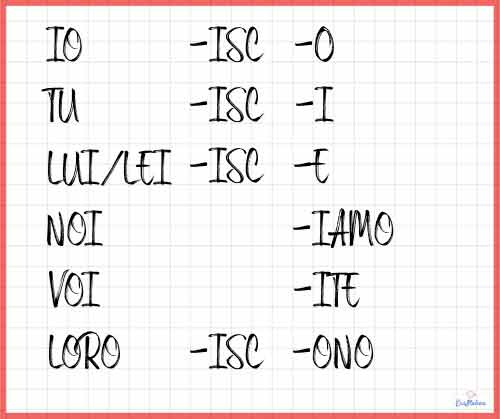
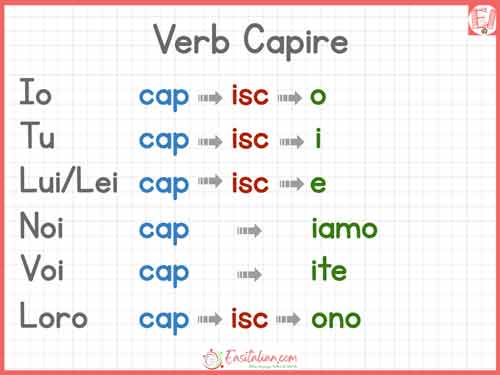
How to easily remember all these rules of verb conjugations.
Here some examples for the present tense.
1st person singular ⇒ IO (I)
See the three conjugations together and notice that the endings for this IO it’s always -O for all the conjugations.
IO lavoro
IO vedo
IO sento
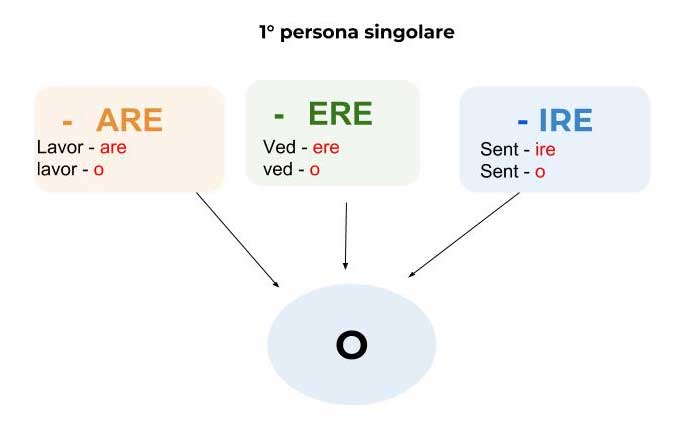
2nd person singular ⇒ TU (YOU sing)
See the three conjugations together and notice that the endings for this TU it’s always -I for all the conjugations.
TU lavori
TU vedi
TU senti
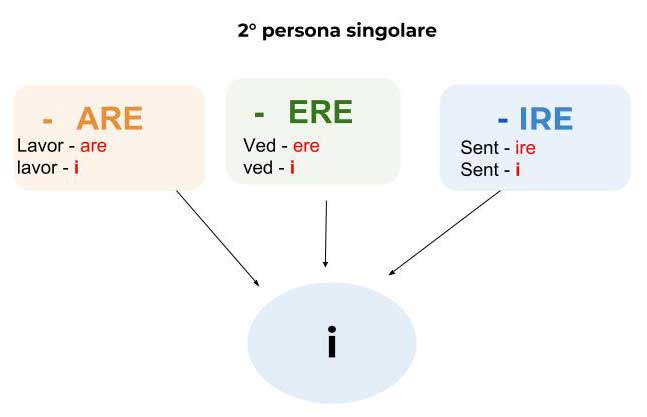
3rd person singular ⇒ LUI/LEI (HE/SHE)
See the three conjugations together and notice that the endings for this LUI/LEI are different for the conjugation ARE from ERE and IRE
LUI/LEI lavora
LUI/LEI vede
LUI/LEI sente
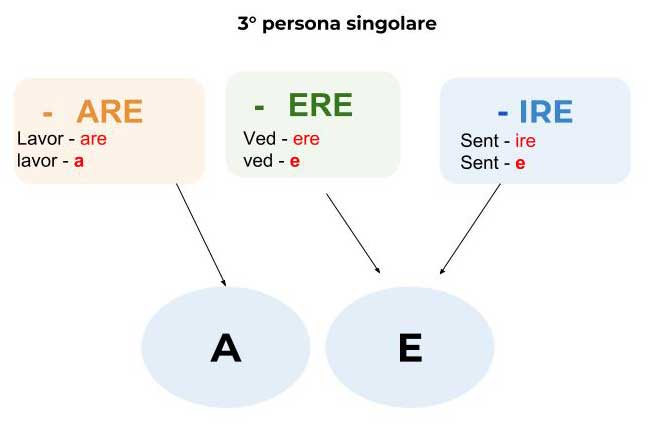
1st person plural ⇒ NOI (WE)
See the three conjugations together and notice that the endings for this NOI it’s always -IAMO for all the conjugations.
NOI lavoriamo
NOI vediamo
NOI sentiamo

2nd person plural ⇒ VOI (YOU plur.)
See the three conjugations together and notice that the endings for this VOI are different for all the conjugations ARE/ ERE/IRE
VOI lavorate
VOI vedete
VOI sentite
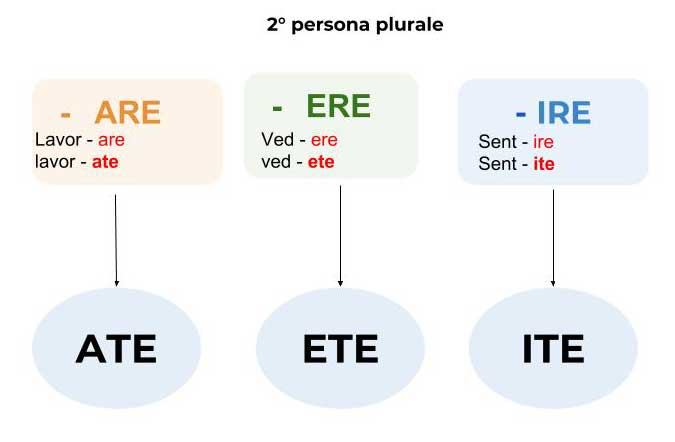
3rd person plural ⇒ LORO (THEY)
See the three conjugations together and notice that the endings for this LORO are different for the conjugation ARE from ERE and IRE
LORO lavorano
LORO vedono
LORO sentono
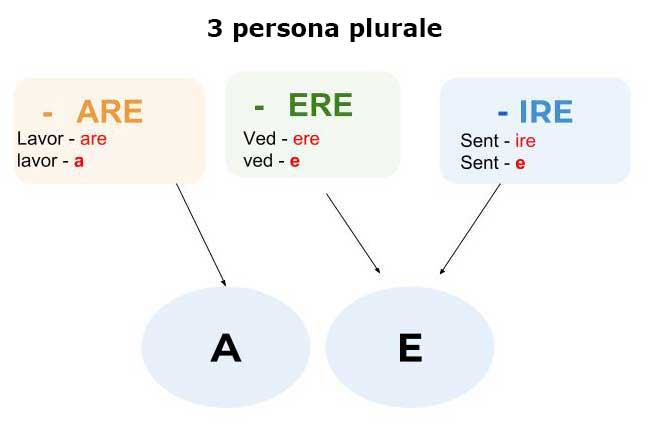
Learning verb conjugations can be challenging, but persistence and patience are your best allies. Don’t get discouraged by initial setbacks. Consistent practice and a positive attitude will ultimately lead to success.
Breaking it down into manageable steps, using helpful resources, and maintaining a regular practice routine can make the learning process smoother and more enjoyable. So, embrace the beauty of the Italian language and let verb conjugations become a natural part of your linguistic journey.

What’s next?
You might want to keep learning Italian online with these free resources:









Leave a Reply